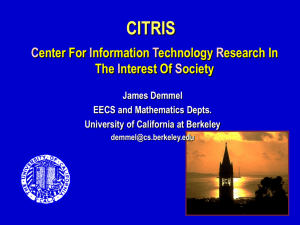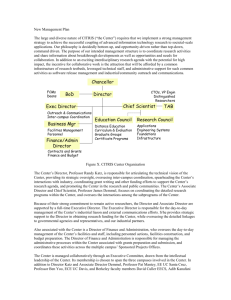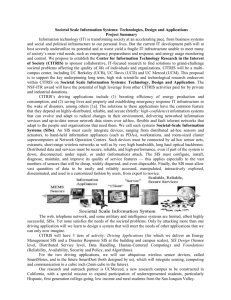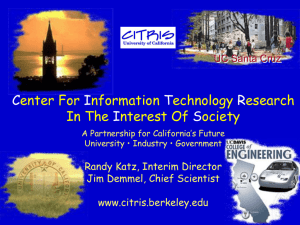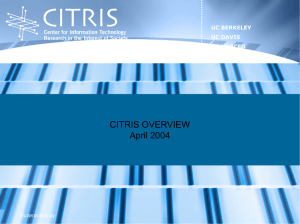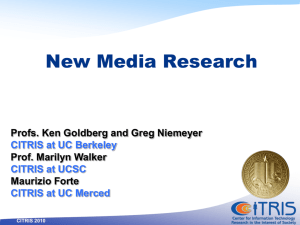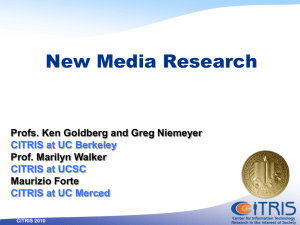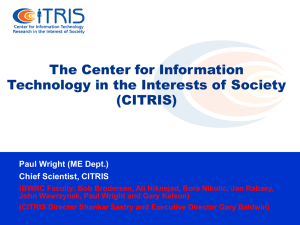CITRIS - Computer Science Division
advertisement
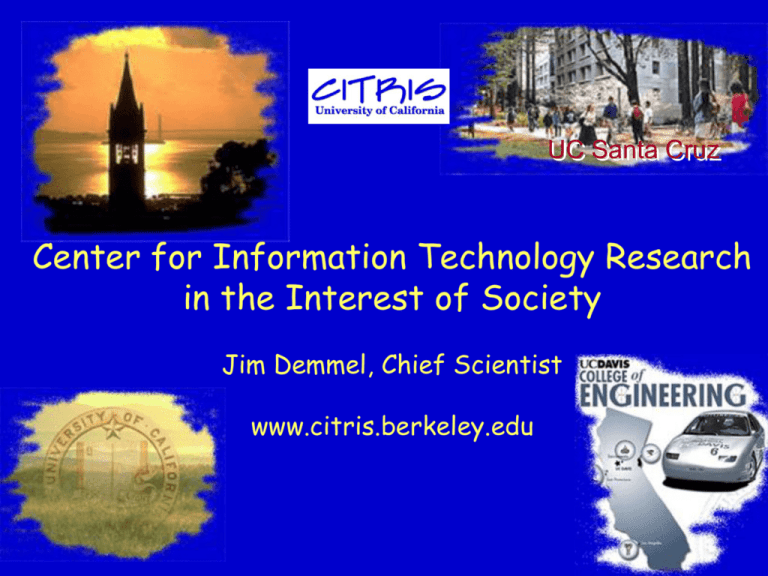
UC Santa Cruz Center for Information Technology Research in the Interest of Society Jim Demmel, Chief Scientist www.citris.berkeley.edu Center For Information Technology Research In The Interest Of Society “Never doubt that a small group of thoughtful committed citizens can change the world. Indeed, it is the only thing that ever has.” –Margaret Mead Major new initiative within the College of Engineering and on the Berkeley Campus Joint with UC Davis, UC Merced, UC Santa Cruz, LBNL, LLNL Over 90 faculty from 21 departments Many industrial partners Significant State and private support CITRIS will focus on IT solutions to tough, quality-of-life related problems Outline Scientific Agenda Overview Hardware and Software Building Blocks New personnel and facilities Affiliated research centers and activities Financial Building Blocks Sensor Networks, Handheld devices, Wireless Networks, Clusters Organizational Building Blocks Applications, Systems, Foundations Industrial partners, funding Current grants Putting the Social into CITRIS Smart Energy – one application in detail Next steps Scientific Agenda Overview Technology Invention in a Social Context: Quality of Life Impact Energy Efficiency Transportation Planning Monitoring Health Care Technology Invention in a Social Context: Quality of Life Impact Education Land and Environment Disaster Response The CITRIS Model Core • Distributed Info Systems Technologies • Micro sensors/actuators • Human-Comp Interaction • Prototype Deployment Applications • Initially Leverage Existing Expertise on campuses Societal-Scale Information Systems (SIS) Foundations • Reliablity • Availability • Security, • Algorithms • Social, policy issues Initial CITRIS Applications (1) Saving Energy Smart Buildings that adjust to inhabitants Make energy deregulation work via real-time metering and pricing Large potential savings in energy costs: for US commercial buildings Turning down heat, lights saves up to $55B/year, 35M tons C emission/year 30% of $45B/year energy bill is from “broken systems” Transportation Systems Use SISs to improve the efficiency and utility of highways while reducing pollution Improve carpooling efficiency using advanced scheduling Improve freeway utilization by managing traffic flows Large potential savings in commuter time, lost wages, fuel, pollution: for CA 15 minutes/commuter/day => $15B/year in wages $600M/year in trucking costs, 150K gallons of fuel/day Disaster Mitigation (natural and otherwise) $100B-$200B loss in “Big One”, 5K to 10K deaths Monitor buildings, bridges, lifeline systems to assess damage after disaster Provide efficient, personalized responses Must function at maximum performance under very difficult circumstances Initial CITRIS Applications (2) Distributed Biomonitoring Wristband biomonitors for chronic illness and the elderly Monitored remotely 24x7x365 Emergency response and potential remote drug delivery Cardiac Arrest Raise out-of-hospital survival rate from 6% to 20% => save 60K lives/year Distributed Education Smart Classrooms Lifelong Learning Center for professional education Develop electronic versions of UC Merced’s undergraduate CS curriculum CS3 by Summer 2002 Environmental Monitoring Monitor air quality near highways to meet Federal guidelines Mutual impact of urban and agricultural areas Monitor water shed response to climate events and land use changes Societal-Scale Systems New System Architectures New Enabled Applications Diverse, Connected, Physical, Virtual, Fluid “Server” “Client” Information Appliances MEMS Sensors Massive Cluster Gigabit Ethernet Clusters Scalable, Reliable, Secure Services Societal-Scale Information System (SIS) Information Utility – Planetary-scale/non-stop; secure, reliable, highperformance access, even when overloaded, down, disconnected, under repair, under attack Smart System – Learns usage/adapts functions & interfaces Managing Diversity – Component plug-and-play; integrate sensors / actuators, hand-held appliances, workstations, building-sized cluster supercomputers Always Connected – Short-range wireless nets to high-bandwidth, highlatency long-haul optical backbones Some SIS Design Research Problems Sensor network level architecture Culler, Pister, Rabaey, Brodersen, Boser,… How to program, synch, maintain sensor net Service architecture for distributed systems Katz, Joseph, Kubiatowicz, Brewer, … How to create, peer, interface services in real time Adaptive data management and query processing Franklin, Hellerstein, … How to collect, summarize, filter, index sensor data Human centered computing Canny, Hearst, Landay, Mankoff, Morgan, Feldman, … How to determine and support needs of diverse users Some Foundational Research Problems How do we make SISs secure? Tygar, Wagner, Samuelson, … Lightweight authentication and digital signatures Graceful degradation after intrusion Protecting privacy, impact of related legislation How do we make SISs reliable? Henzinger, Aiken, Necula, Sastry, Wagner, … Complexity => hybrid modeling Multi-aspect interfaces to reason about properties Software quality => combined static/dynamic analysis How do we make SISs available? Patterson, Yelick, … Repair-Centric Design Availability modeling and benchmarking Performance fault adaptation What algorithms do we need? Papadimitriou, Demmel, Jordan, … Algorithm to design, operate and exploit data from SISs Hardware and Software Building Blocks Experimental Testbeds in UCB EECS Soda Hall IBM WorkPad Velo Nino Smart Dust LCD Displays MC-16 Motorola Pagewriter 2000 CF788 Smart Classrooms Audio/Video Capture Rooms Pervasive Computing Lab CoLab WLAN / Bluetooth Wearable Displays GSM BTS Pager H.323 GW Network Infrastructure TCI @Home Adaptive Broadband LMDS Millennium Cluster Millennium Cluster CalRen/Internet2/NGI PicoRadio Extending the Scope and … Pushing the Envelope Wireless node Offices Entrance Exhibits Cafe Smart Dust MEMS-Scale Sensors/Actuators/Communicators Create a dynamic, ad-hoc network of power-aware sensors Explore system design issues Provide a platform to test Dust components Use off the shelf components initially Current One-Inch Networked Sensor Culler, Pister 1” x 1.5” motherboard ATMEL 4Mhz, 8bit MCU, 512 bytes RAM, 8K pgm flash 900Mhz Radio (RF Monolithics) 10-100 ft. range Radio Signal strength control and sensing Base-station ready stackable expansion connector all ports, i2c, pwr, clock… Several sensor boards basic protoboard tiny weather station (temp,light,hum,press) vibrations (2d acc, temp, light) accelerometers magnetometers TinyOS Approach Stylized programming model with extensive static information Program = graph of TOS components TOS component = command/event interface + behavior Rich expression of concurrency Events propagate across many components Tasks provide internal concurrency Regimented storage management Very simple implementation For More see http://tinyos.millennium.berkeley.edu Emerging “de facto” tiny system Feb. 01 bootcamp 40 people UCB, UCLA, USC, Cornell, Rutgers, Wash., LANL, Bosch, Accenture, Intel, crossbow Several groups actively developing around tinyOS on “rene” node Concurrency framework has held up well. Next generation(s) selected as DARPA networked embedded system tech (NEST) open platform Smaller building blocks for ubicomp Micro Flying Insect ONR MURI/ DARPA funded Year 3 of 5 year project Professors Dickinson, Fearing (PI), Liepmann, Majumdar, Pister, Sands, Sastry Synthetic Insects (Smart Dust with Legs) Goal: Make silicon walk. •Autonomous •Articulated •Size ~ 1-10 mm •Speed ~ 1mm/s MEMS Technology Roadmap (Pisano/BSAC) 2010 2005 2004 MEMS Micro Sensor Networks (Smart Dust) 2002 2003 MEMS Immunological Sensors MEMS “Mechanical” Micro Radios MEMS Rotary Engine Power System MEMS Single Molecule Detection Systems Organizational Building Blocks CITRIS Director Prof. Ruzena Bajcsy Distinguished engineer, member of NAE/NIM Senior professor at UPenn, with appointments in CIS, MechE, Medical School Established & ran major interdisciplinary research laboratory Major leadership & management experience in DC federal agencies—Assistant Director, CISE, NSF Served as Department Chair, 1986-1990 Highly influential among leaders of CS field and national research funding circles Strong advocate for women in technical careers CITRIS-Affiliated Research Activities (please send contributions!) International Computer Science Institute (ICSI) (5 faculty, 18 students) studies network protocols and applications and speech and language-based humancentered computing. Millennium Project (15 faculty) is developing a powerful, networked computational test bed of nearly 1,000 computers across campus to enable interdisciplinary research. Berkeley Sensor and Actuator Center (BSAC) (14 faculty, 100 students) is a world-leading effort specializing in micro-electromechanical devices (MEMS), micro-fluidic devices, and “smart dust.” Microfabrication Laboratory (71 faculty, 254 students) is a campus-wide resource offering sophisticated processes for fabricating micro-devices and micro-systems. Gigascale Silicon Research Center (GSRC) (23 faculty, 60 students) addresses problems in designing and testing complex, single-chip embedded systems using deep sub-micron technology. Berkeley Wireless Research Center (BWRC) (16 faculty, 114 students) is a consortium of companies and DARPA programs to support research in lowpower wireless devices. CITRIS-Affiliated Research Activities (continued) Berkeley Information Technology and Systems (BITS) (20 faculty, 60 students) a new networking research center will address large emerging networking problems (EECS, ICSI, SIMS) Berkeley Institute of Design (BID) (10 faculty) a new interdisciplinary center (EECS, ME, Haas, SIMS, IEOR, CDV, CED, Art Practice) to study the design of software, products and living spaces based on the convergence of design practices in information technology, industrial design, and architecture Center for Image Processing and Integrated Computing (CIPIC) (8 faculty, 50 students) (UCD) focuses on data analysis, visualization, computer graphics, optimization, and electronic imaging of large-scale, multi-dimensional data sets. Applications-Related Current Activities (please send contributions!) Partners for Advanced Transit and Highways, PATH, (20 faculty, 70 students), a collaboration between UC, Caltrans, other universities, and industry to develop technology to improve transportation in California. Berkeley Seismological Laboratory (15 faculty, 14 students) operates, collects, and studies data from a regional seismological monitoring system, providing earthquake information to state and local governments. Pacific Earthquake Engineering Research Center, PEER ( 25 faculty, 15 students), a Berkeley-led NSF center, is a consortium of nine universities (including five UC campuses) working with industry and government to identify and reduce earthquake risks to safety and to the economy. National Center of Excellence in Aviation Operations Research, NEXTOR (6 faculty, 12 students), a multi-campus center, models and analyzes complex airport and air traffic systems. Applications-Related Current Activities (continued) Center for the Built Environment (CBE) (19 faculty/staff) provides timely, unbiased information on promising new building technologies and design techniques. Lawrence Berkeley National Laboratory (LBNL) National Energy Research Supercomputing Center (NERSC) provides high- performance computing tools and expertise that enable computational science of scale Environmental Energy Technologies (EET) performs research and development leading to better energy technologies and reduction of adverse energy-related environmental impacts. Center for Environmental and Water Resources Engineering (CEWRE) (9 faculty, 45 students) (UCD) applications of advanced methods to environmental and water management problems. Financial Building Blocks California Institutes in Science and Technology Governor Gray Davis’ Initiative $100M state funding for capital projects over 4 years--matched 2:1 by Federal, industrial, private support Focus on “hot” areas for 21st Century, limited to UC campuses Three initially funded: UCSF/UCB/UCSC (Bioinformatics) UCLA/UCSB (Nanotechnology) UCSD/UCI (Information Technology) UCB-led CITRIS proposal in 2001-2002 State budget New CITRIS Facilities Cory Hall EECS Soda Hall EECS Cory Refurbishment (Berkeley) CITRIS Building (Berkeley) Engineering Building (Santa Cruz) CITRIS Network (Davis, Berkeley, Merced, SC) Committed Support from Industry Founding Corporate Members of CITRIS We have received written pledges to CITRIS of over $170 million from individuals and corporations committed to the CITRIS longrange vision Large NSF ITR Award $7.5M over 5 years Support for 30 faculty (Berkeley, Davis) for subset of CITRIS 2 applications: Energy (Rabaey, Pister, Arens, Sastry) Disaster Response (Fenves, Glaser, Kanafani, Demmel) Most SW aspects of systems, no hardware Service architecture (Katz, Joseph) Data/Query management (Franklin, Hellerstein) Human Centered Computing (Canny, Hearst, Landay, Saxenian) Data Visualization (Hamann, Max, Joy, Ma, Yoo) Sensor Network Architecture (Culler, Pister) (in original proposal, reduced support) Collaboration with UC Merced www.cs.berkeley.edu/~demmel/ITR_CITRIS CommerceNet Incubator State-funded NGI (Next Generation Internet) incubator http://www.commerce.net At Bancroft/Shattuck in shared CCIT space http://www.path.berkeley.edu/PATH/CCIT/Default.htm Companies will incubate and collaborate with CITRIS faculty and students Kalil, Demmel, Sastry, Teece (advisors) http://www.cs.berkeley.edu/~demmel/CommerceNet Companies chosen for closeness to CITRIS WEbS - Wireless Embedded Systems $2.44M from DARPA’s Networked Embedded Systems (NEST) program Culler, Brewer, Wagner, Sastry, Pister, 13 students Development of “rene” node and tinyOS Upcoming Boot Camp to program nodes Other support Long list, at least $27M More pending More proposals being written Putting the “Social” into CITRIS Courtesy of John Canny, Tom Kalil More input requested! Bringing the “social” into CITRIS CITRIS needs to engage Sociologists Economists Anthropologists Lawyers Political scientists Scholars of public policy Business-school faculty … Possible roles for Social Scientists Address risks (e.g. privacy of sensor nets) Examine deployment issues associated with SISs Economic, social, legal factors in rate of deployment User-centered design (e.g. ethnography) Suggest new application areas or themes Broader ethical, legal, social implications of the Information Revolution See web page for more extensive document www.citris.berkeley.edu, click on “Kick Off” Energy Efficiency Detailed Example The Inelasticity of California’s Electrical Supply 800 700 $/MWh 600 500 400 300 200 100 0 20000 25000 30000 35000 40000 45000 MW Power-exchange market price for electricity versus load (California, Summer 2000) How to Address the Inelasticity of the Supply Spread demand over time (or reduce peak) Make cost of energy visible to end-user function of load curve (e.g. hourly pricing) “demand-response” approach Reduce average demand (demand side) Eliminate wasteful consumption Improve efficiency of equipment and appliances Improve efficiency of generation and distribution network (supply side) Enabled by Information! Energy Consumption in Buildings (US 1997) End Use Space heating Space cooling Water heating Refrigerator/Freezer Lighting Cooking Clothes dryers Color TVs Ventilation/Furnace fans Office equipment Miscellaneous Total Residential 6.7 1.5 2.7 1.7 1.1 0.6 0.6 0.8 0.4 3.0 19.0 (Units: quads per year = 1.05 EJ y-1) Source: Interlaboratory Working Group, 2000 Commercial 2.0 1.1 0.9 0.6 3.8 0.6 1.4 4.9 15.2 A Three-Phase Approach Phase 1: Passive Monitoring The availability of cheap, connected (wired or wireless) sensors makes it possible for the end-user to monitor energy-usage of buildings and individual appliances and act there-on. Primary feedback on usage Monitor health of the system (30% inefficiency!) Phase 2: Quasi-Active Monitoring and Control Combining the monitoring information with instantaneous feedback on the cost of usage closes the feedback loop between end-user and supplier. Phase 3: Active Energy-Management through Feedback and Control—Smart Buildings and Intelligent Appliances Adding instantaneous and distributed control functionality to the sensoring and monitoring functions increases energy efficiency and user comfort Smart Buildings Dense wireless network of sensor, control, and actuator nodes • Task/ambient conditioning systems allow conditioning in small, localized zones, to be individually controlled by building occupants and environmental conditions • Joined projects between BWRC/BSAC, School of Architecture (CBE), Civil Engineering, and IEOR with Berkeley and Santa Cruz A Proof-of-Concept: A six month demonstration, already underway! Leaders: Pister, Culler, Trent, Sastry, Rabaey “Easy”: Fully instrument a number of buildings on campus with networked light and temperature sensors in every room, and make the data available on a centralized web-site. “Medium”: Make a wireless power monitor with a standard 3-prong feedthrough receptacle so that people can monitor power consumption of electronic devices as a function of time. Similar device, but passively coupled to high-power wiring to monitor total power consumption through breaker boxes. This would give us a much finer granularity of power-consumption details, and let us look at clusters of rooms, floors, etc. Fully instrument the campus power distribution system “Hard”: Real-time monitoring and control of hundreds of power systems on campus. Enforce compliance with load reduction. Charge/reward departments according to their use during peak times. Energy References www.citris.berkeley.edu, Click on Smart Energy Severin Borenstein’s paper on California’s electricity deregulation disaster haas.berkeley.edu/~borenste/CATrouble.pdf Next Steps How to participate You probably are already (in technology) Get the big picture Application motivation important Participate in interdisciplinary collaborations On-line material www.citris.berkeley.edu www.cs.berkeley.edu/~demmel/ITR_CITRIS www.cs.berkeley.edu/~demmel/CommerceNet Other faculty pages Workshops Mote Boot Camp by Culler on Oct 17 webs.cs.berkeley.edu/bootcamp.html More being planned on applications and technology What is the future of information technology? Increasingly, symbiosis with other fields, impact on society
